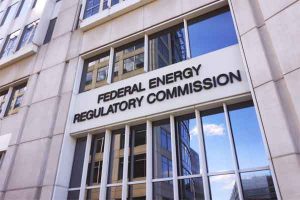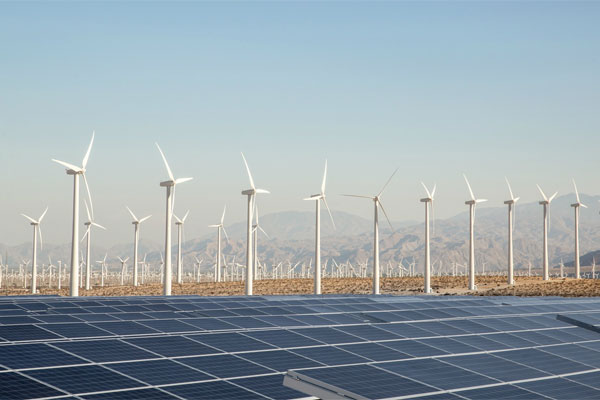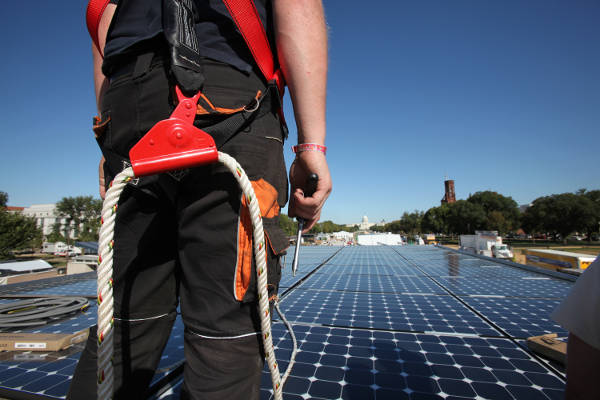Washington DC – According to a review by the SUN DAY Campaign of data just released by the Federal Energy Regulatory Commission (FERC), the agency has once again revised its three-year forecast for changes in the U.S. electrical generating capacity mix. Sharp declines are foreseen for fossil fuels and nuclear power while renewable energy (i.e., biomass, geothermal, hydropower, solar, wind) is forecast to experience even stronger growth than previously projected.
FERC’s latest monthly “Energy Infrastructure Update” report (with data through August 31, 2019) indicates that “proposed additions under construction” and “proposed retirements” combined could result in a net decrease in the generating capacity of fossil fuels (i.e., coal, natural gas, oil) as well as a net decline of nearly five percent (4.56%) in nuclear capacity by August 2022.
Meanwhile, led by wind and solar, the generating capacity of renewable energy sources is foreseen to grow by more than 47 gigawatts (GW).
While net new natural gas generating capacity is projected to increase by 19,757 megawatts (MW), that is more than offset by a drop of 18,957 MW in coal’s net generating capacity and a decline of 3,016 MW in that of oil. Further, nuclear power is foreseen as dropping by 4,851 MW.
Meanwhile, wind capacity is projected to grow by 27,659 MW and utility-scale solar by 17,857 MW. The other renewable sources would also increase: hydropower by 1,282 MW, biomass by 333 MW, and geothermal by 280 MW.

The Federal Energy Regulatory Commission is the United States federal agency that regulates the transmission and wholesale sale of electricity and natural gas in interstate commerce and regulates the transportation of oil by pipeline in interstate commerce.
Collectively, they would add 47,411 MW over the next three years. That is significantly more than double the projected growth in natural gas generating capacity. In fact, net new wind capacity alone is greater than that of natural gas.
While earlier FERC data had documented this general trend, the agency’s latest numbers seem to be particularly noteworthy because a modification in how FERC now presents its data, compared to six months earlier, suggests changes in the nation’s energy mix may be accelerating.
Specifically, FERC’s most recent three-year forecast for net new generating capacity by wind is 3,099 MW higher than a comparable forecast in its “Energy Infrastructure Report for February 2019” while that for utility-scale solar has grown by 5,809 MW. Including hydropower, biomass, and geothermal, the cumulative result is an increase over the past six months in FERC’s three-year forecast for net new generating capacity by renewable energy sources from 37,622 MW to 47,411 — i.e., 26.0% higher.
On the other hand, in its February 2019 report, FERC anticipated net cumulative growth by fossil fuels of 5,087 MW over the next three years. Now FERC foresees a net decline in fossil fuel generating capacity of 2,216 MW. Notably, net new additions to natural gas capacity are 3,753 MW lower than they were forecast to be six months ago.
FERC also projects that the capacity of new coal plants over the next three years will be zero because none are under construction. In fact, if FERC’s latest projections prove accurate, in three years, coal’s share of the nation’s total available installed generating capacity would drop from 21.37% today to 19.14% three years hence.
Meanwhile, renewable energy sources will continue to expand. They would provide nearly one-quarter (i.e., 24.80%) of the nation’s total available installed generating capacity by August 2022 (compared to 21.69% today) with wind alone accounting for over a tenth (10.29%) and utility-scale solar at 4.63%. The balance will be provided by hydropower (8.23%), biomass (1.32%), and geothermal (0.33%).
“FERC’s latest three-year projections continue to underscore the dramatic changes taking place in the nation’s electrical generating mix,” noted Ken Bossong, executive director of the SUN DAY Campaign. “Renewable energy sources are rapidly displacing uneconomic and environmentally dangerous fossil fuels and nuclear power – even faster than FERC had anticipated just a half-year ago.”














Comments